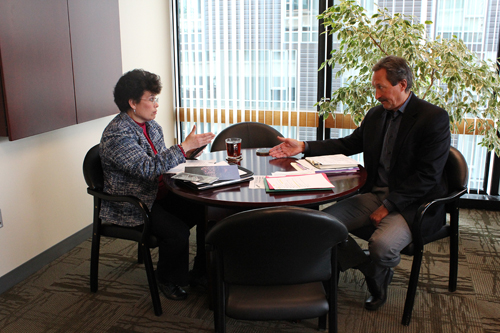There’s a lone smoking shelter between Smith Memorial Student Union and Cramer Hall, but despite the “no smoking” signs posted on the bench next to it, some people still sit there to have a cigarette between classes. The current Portland State smoking policy mandates that certain areas remain smoke-free and prohibits smoking within 25 feet of doorways, building entrances and exits, operable windows and other areas. Signs are posted all over campus, reminding the PSU community of the rules and regulations. Despite the signs, some designated smoke-free areas remain problematic. Soon, however, this could change.
Campus smoking policy under review
There’s a lone smoking shelter between Smith Memorial Student Union and Cramer Hall, but despite the “no smoking” signs posted on the bench next to it, some people still sit there to have a cigarette between classes. The current Portland State smoking policy mandates that certain areas remain smoke-free and prohibits smoking within 25 feet of doorways, building entrances and exits, operable windows and other areas. Signs are posted all over campus, reminding the PSU community of the rules and regulations. Despite the signs, some designated smoke-free areas remain problematic. Soon, however, this could change.
Task force finds unmet needs on campus
Portland State has two childcare centers, and both are full. More than 1,000 students are on waiting lists for on-campus childcare, and many more don’t even apply, because they know there is no room. But, while few people picture an undergrad traipsing to class with a backpack, a diaper bag and a breast pump, times are changing. Universities are looking to meet the demands of a new type of college student.
Drop, cover and hold
The shaking could last for up to five minutes. Bridges, roads and buildings could crumble. Schools and businesses could close indefinitely. Much needed infrastructure—power, water, sewage and phone lines—could be down for months. The Interstate 5 corridor could be in ruins, wreaking havoc on supply chains as it becomes increasingly difficult to distribute food, medicine and other critical resources. A major earthquake could forever change lives.
Earthquake preparedness at Portland State
Last week, the Vanguard reported on the potential for a major earthquake in the Pacific Northwest [“Megathrust earthquakes in the Pacific Northwest,” Feb. 9]. Portland State geology professor Dr. Scott Burns said that sometime in the next 50 years there is a 15 percent chance of a catastrophic earthquake with a magnitude of 9 or greater and a 37 percent chance of an earthquake with a magnitude of 8 or greater.
Megathrust earthquakes in the Pacific Northwest
Major earthquakes over the last several years have made headlines and captured everyone’s attention. According to the United States Geological Survey, the Haitian earthquake in 2010 killed over 200,000 people and left over a million homeless. Several months later, an 8.8 magnitude quake struck Chile and caused the equivalent of 30 billion U.S. dollars in damage. More recently, Japan experienced a tragedy that is still being tallied. Could something like this happen in the Pacific Northwest?
Budgetary concerns, enrollment growth factors in changing faculty demographics
Portland State is growing, tuition is on the rise and state funding is declining. In response to this reality, the university is increasingly relying on part-time and full-time fixed-term faculty positions in order to meet the instructional needs of students. According to Roy Koch, provost and vice president for Academic Affairs, PSU is “leading what will be a national trend—this shift of faculty mix, because the issue of state funding is becoming more and more widespread across the country.
PSU hosts study abroad fair on Jan. 26
On Jan. 26, Portland State will host a fair for students interested in learning about studying abroad. With more than 100 programs in over 40 countries, the fair provides students with an opportunity to explore the different study abroad options, such as terms abroad, internships and short-term, faculty-led courses. The event will be held from 11 a.m. to 2 p.m. in the Smith Memorial Student Union Ballroom, room 355.
With so many different programs and places to consider, the fair offers students a one-stop place to ask questions about available programs and financial aid opportunities. According to Blythe Knott, education abroad advisor for the Office of International Affairs, the fair can help students determine their main priorities for selecting a program, such as pinpointing academic interest and affordability.
Navigating the maze of campus resources
Conflict resolution is rarely an easy task. Prior to June 2011, if students had an academic issue, a difficulty with a colleague or supervisor or a more serious problem, they would have been able to walk into the Ombuds Office for help.
Since the office’s closure, access to resources has been rerouted. Student-related issues are now handled by the Office of the Dean of Student Life. Issues involving faculty and employees have been channeled to Human Resources and Academic Affairs.
Comfort food for holiday entertaining
If you’re racking your brain to figure out how to throw a holiday dinner party without serving ramen, then this is the meal for you. Everything can be cooked on one burner, in stages. The ingredients are inexpensive, but the result is a creamy, delicious chicken stew and a dessert that is deceptively simple to make but will have your friends thinking you are a true gourmand.
City officials tallying the costs of Occupy Portland movement
As a somewhat soggy peace and quiet returns to our downtown parks, officials are gathering estimates of the financial impact of the Occupy Portland movement.
The Portland Police Bureau, Portland Parks and Recreation and the Regional Arts and Culture Council are including overtime, repairs and cleanup costs in the estimates.
Chapman Square and Lownsdale Park, home to the Occupy Portland movement from Oct. 6 to Nov. 13, are now fenced off and awaiting restoration and repairs. The city is in the process of assessing the damage to the park, but Mike Ross, public information officer at Portland Parks and Recreation, expects the damage to fall between $50,000 and $100,000. The city is looking at reseeding and irrigation, structural, plumbing and electrical repairs. Ross is unsure when the estimates and repairs will be completed.




